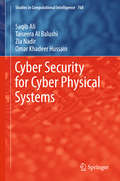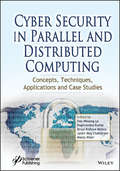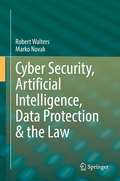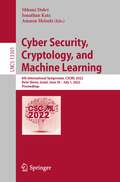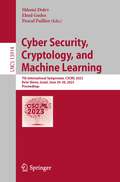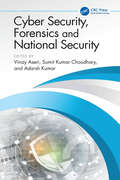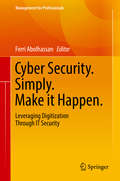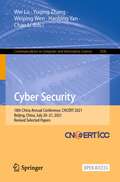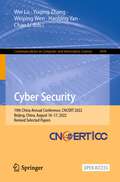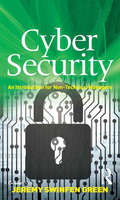- Table View
- List View
Cyber Security for Cyber Physical Systems (Studies In Computational Intelligence #768)
by Omar Khadeer Hussain Saqib Ali Taiseera Al Balushi Zia NadirThis book is a pioneering yet primary general reference resource on cyber physical systems and their security concerns. Providing a fundamental theoretical background, and a clear and comprehensive overview of security issues in the domain of cyber physical systems, it is useful for students in the fields of information technology, computer science, or computer engineering where this topic is a substantial emerging area of study.
Cyber Security for Next-Generation Computing Technologies
by Mariya Ouaissa Mariyam Ouaissa Muhammad Fazal Ijaz Inam Ullah Khan Zakaria Abou El HoudaThis book sheds light on the cyber security challenges associated with nextgeneration computing technologies, emphasizing the serious threats posed to individuals, businesses, and nations. With everything becoming increasingly interconnected via the Internet, data security becomes paramount. As technology advances, people need to secure their data communication processes. Personal data security, including data integrity and confidentiality, is particularly vulnerable. Therefore, the concept of cyber security forensics emerges to ensure data security for everyone, addressing issues such as data control, hijacking, and threats to personal devices such as mobile phones, laptops, and other smart technologies. This book covers key topics related to cyber security in next-generation computing technologies, ultimately enhancing the quality of life for citizens, facilitating interaction with smart governments, and promoting secure communication processes. KEY FEATURES • Highlights innovative principles and practices using next generation computing technologies based cybersecurity. • Presents an introduction to recent trends regarding the convergence of AI/ML in cybersecurity • Offers an overview of theoretical, practical, simulation concepts of cybersecurity
Cyber Security in Business Analytics (Artificial Intelligence, Machine Learning, Data Analytics and Automation for Business Management)
by Hong Lin Gururaj H L B Ramesh Chandrika JThere is a growing need for insights and practical experiences in the evolving field of cyber security for business analytics a need addressed by Cyber Security in Business Analytics. Divided into sections covering cyber security basics, artificial intelligence (AI) methods for threat detection, and practical applications in e-commerce and e-banking, the book's team of experts provides valuable insights into securing business data and improving decision-making processes. It covers topics such as data privacy, threat detection, risk assessment, and ethical considerations, catering to both technical and managerial audiences.• Presents real-case scenarios for enhancing understanding of how cyber security principles are applied in diverse organizational settings• Offers advanced technologies such as artificial intelligence methods for cyber threat detection, offering readers• Provides a detailed exploration of howAI can make cybersecurity better by helping detect threats, unusual activities, and predict potential risks• Focuses on the convergence of cyber security and data-driven decision-making and explores how businesses can leverage analytics while safeguarding sensitive information• Includes insights into cutting-edge techniques in the field, such as detailed explorations of various cyber security tools within the context of business analyticsCyber Security in Business Analytics will be useful for scholars, researchers and professionals of computer science and analytics.
Cyber Security in India: Education, Research and Training (IITK Directions #4)
by Sandeep Kumar Shukla Manindra AgrawalThis book of 'directions' focuses on cyber security research, education and training in India, and work in this domain within the Indian Institute of Technology Kanpur. IIT Kanpur's Computer Science and Engineering Department established an ‘Interdisciplinary Center for Cyber Security and Cyber Defense of Critical Infrastructures (C3I Center)’ in 2016 with funding from the Science and Engineering Research Board (SERB), and other funding agencies. The work at the center focuses on smart grid security, manufacturing and other industrial control system security; network, web and data security; cryptography, and penetration techniques. The founders are involved with various Indian government agencies including the Reserve Bank of India, National Critical Information Infrastructure Protection Center, UIDAI, CCTNS under home ministry, Ministry of IT and Electronics, and Department of Science & Technology. The center also testifies to the parliamentary standing committee on cyber security, and has been working with the National Cyber Security Coordinator's office in India. Providing glimpses of the work done at IIT Kanpur, and including perspectives from other Indian institutes where work on cyber security is starting to take shape, the book is a valuable resource for researchers and professionals, as well as educationists and policymakers.
Cyber Security in Intelligent Computing and Communications (Studies in Computational Intelligence #1007)
by Jing He Sanjeev Kumar Rajeev Agrawal Emmanuel Shubhakar PilliThis book looks at cyber security challenges with topical advancements in computational intelligence and communication technologies. This book includes invited peer-reviewed chapters on the emerging intelligent computing and communication technology research advancements, experimental outcomes, and cyber security practices, threats, and attacks with challenges. The book begins with a state-of-the-art survey and reviews of cyber security trends and issues. It further covers areas such as developments in intelligent computing and communication, smart healthcare, agriculture, transportation, online education, and many more real-life applications using IoT, big data, cloud computing, artificial intelligence, data science, and machine learning. This book is of interest to graduate/postgraduate students, researchers, and academicians. This book will be a valuable resource for practitioners and professionals working in smart city visualization through secure and intelligent application design, development, deployment to foster digital revolution, and reliable integration of advanced computing and communication technologies with global significance.
Cyber Security in Parallel and Distributed Computing: Concepts, Techniques, Applications and Case Studies
by Dac-Nhuong Le Raghvendra Kumar Jyotir Moy Chatterjee Manju Khari Brojo Kishore MishraThe main objective of this book is to explore the concept of cybersecurity in parallel and distributed computing along with recent research developments in the field. It also includes various real-time/offline applications and case studies in the fields of engineering and computer science and the modern tools and technologies used. Information on cybersecurity technologies is organized in the fifteen chapters of this book. This important book cover subjects such as: Research and solutions for the problem of hidden image detection Security aspects of data mining and possible solution techniques A comparative analysis of various methods used in e-commerce security and how to perform secure payment transactions in an efficient manner Blockchain technology and how it is crucial to the security industry Security for the Internet of Things Security issues and challenges in distributed computing security such as heterogeneous computing, cloud computing, fog computing, etc. Demonstrates the administration task issue in unified cloud situations as a multi-target enhancement issue in light of security Explores the concepts of cybercrime and cybersecurity and presents the statistical impact it is having on organizations Highlights some strategies for maintaining the privacy, integrity, confidentiality and availability of cyber information and its real-world impacts such as mobile security software for secure email and online banking, cyber health check programs for business, cyber incident response management, cybersecurity risk management Security policies and mechanisms, various categories of attacks (e.g., denial-of-service), global security architecture, along with distribution of security mechanisms Security issues in the healthcare sector with existing solutions and emerging threats.
Cyber Security in the Age of Artificial Intelligence and Autonomous Weapons
by Mehmet Emin ErendorAlthough recent advances in technology have made life easier for individuals, societies, and states, they have also led to the emergence of new and different problems in the context of security. In this context, it does not seem possible to analyze the developments in the field of cyber security only with information theft or hacking, especially in the age of artificial intelligence and autonomous weapons. For this reason, the main purpose of this book is to explain the phenomena from a different perspective by addressing artificial intelligence and autonomous weapons, which remain in the background while focusing on cyber security. By addressing these phenomena, the book aims to make the study multidisciplinary and to include authors from different countries and different geographies. The scope and content of the study differs significantly from other books in terms of the issues it addresses and deals with.When we look at the main features of the study, we can say the following: Handles the concept of security within the framework of technological development Includes artificial intelligence and radicalization, which has little place in the literature Evaluates the phenomenon of cyber espionage Provides an approach to future wars Examines the course of wars within the framework of the Clausewitz trilogy Explores ethical elements Addresses legal approaches In this context, the book offers readers a hope as well as a warning about how technology can be used for the public good. Individuals working in government, law enforcement, and technology companies can learn useful lessons from it.
Cyber Security on Azure: An IT Professional’s Guide to Microsoft Azure Security
by Marshall Copeland Matthew JacobsPrevent destructive attacks to your Azure public cloud infrastructure, remove vulnerabilities, and instantly report cloud security readiness. This book provides comprehensive guidance from a security insider's perspective.Cyber Security on Azure supports cloud security operations and cloud security architects by supplying a path to clearly identify potential vulnerabilities to business assets and reduce security risk in Microsoft Azure subscription. This updated edition explores how to “lean-in” and recognize challenges with IaaS and PaaS for identity, networks, applications, virtual machines, databases, and data encryption to use the variety of Azure security tools. You will dive into Azure Cloud Security to guide cloud operations teams to become more security focused in many areas and laser focused on security configuration. New chapters cover Azure Kubernetes Service and Container security and you will get up and running quickly with an overview of Azure Sentinel SIEM Solution.What You'll LearnUnderstand enterprise privileged identity and security policies"Shift left" with security controls in Microsoft AzureConfigure intrusion detection and alertsReduce security risks using Azure Security ServiceWho This Book Is ForIT, cloud, and security administrators in Azure
Cyber Security on Azure: An IT Professional’s Guide to Microsoft Azure Security Center
by Marshall CopelandPrevent destructive attacks to your Azure public cloud infrastructure, remove vulnerabilities, and instantly report cloud security readiness. This book provides comprehensive guidance from a security insider's perspective. Cyber Security on Azure explains how this 'security as a service' (SECaaS) business solution can help you better manage security risk and enable data security control using encryption options such as Advanced Encryption Standard (AES) cryptography. Discover best practices to support network security groups, web application firewalls, and database auditing for threat protection. Configure custom security notifications of potential cyberattack vectors to prevent unauthorized access by hackers, hacktivists, and industrial spies. What You'll Learn This book provides step-by-step guidance on how to: Support enterprise security policies Improve cloud security Configure intrusion detection Identify potential vulnerabilities Prevent enterprise security failures Who This Book Is For IT, cloud, and security administrators; CEOs, CIOs, and other business professionals
Cyber Security, Artificial Intelligence, Data Protection & the Law
by Robert Walters Marko NovakThis book provides a comparison and practical guide of the data protection laws of Canada, China (Hong Kong, Macau, Taiwan), Laos, Philippines, South Korea, United States and Vietnam. The book builds on the first book Data Protection Law. A Comparative Analysis of Asia-Pacific and European Approaches, Robert Walters, Leon Trakman, Bruno Zeller. As the world comes to terms with Artificial Intelligence (AI), which now pervades the daily lives of everyone. For instance, our smart or Iphone, and smart home technology (robots, televisions, fridges and toys) access our personal data at an unprecedented level. Therefore, the security of that data is increasingly more vulnerable and can be compromised. This book examines the interface of cyber security, AI and data protection. It highlights and recommends that regulators and governments need to undertake wider research and law reform to ensure the most vulnerable in the community have their personal data protected adequately, while balancing the future benefits of the digital economy.
Cyber Security, Cryptology, and Machine Learning: 6th International Symposium, CSCML 2022, Be'er Sheva, Israel, June 30 – July 1, 2022, Proceedings (Lecture Notes in Computer Science #13301)
by Jonathan Katz Shlomi Dolev Amnon MeiselsThis book constitutes the refereed proceedings of the 6th International Symposium on Cyber Security Cryptography and Machine Learning, CSCML 2022, held in Be'er Sheva, Israel, in June - July 2022. The 24 full and 11 short papers presented together with a keynote paper in this volume were carefully reviewed and selected from 53 submissions. They deal with the theory, design, analysis, implementation, or application of cyber security, cryptography and machine learning systems and networks, and conceptually innovative topics in these research areas.
Cyber Security, Cryptology, and Machine Learning: 7th International Symposium, CSCML 2023, Be'er Sheva, Israel, June 29–30, 2023, Proceedings (Lecture Notes in Computer Science #13914)
by Shlomi Dolev Ehud Gudes Pascal PaillierThis book constitutes the refereed proceedings of the 7th International Symposium on Cyber Security, Cryptology, and Machine Learning, CSCML 2023, held in Be'er Sheva, Israel, in June 2023.The 21 full and 15 short papers were carefully reviewed and selected from 70 submissions. They deal with the theory, design, analysis, implementation, and application of cyber security, cryptography and machine learning systems and networks, and conceptually innovative topics in these research areas.
Cyber Security, Cryptology, and Machine Learning: 8th International Symposium, CSCML 2024, Be'er Sheva, Israel, December 19–20, 2024, Proceedings (Lecture Notes in Computer Science #15349)
by Giuseppe Persiano Shlomi Dolev Mirosław Kutyłowski Michael ElhadadThis book constitutes the proceedings of the 8th International Symposium on Cyber Security, Cryptology, and Machine Learning, CSCML 2024, held in Be'er Sheva, Israel, during December 19–20, 2024. The 16 full papers and 11 short papers presented here were carefully reviewed and selected from 43 submissions. These papers focus on the current innovative research developments in the field of cyber security, cryptography, and machine learning systems and networks.
Cyber Security, Forensics and National Security (Advances in Digital Technologies for Smart Applications)
by Adarsh Kumar Vinay Aseri Sumit Kumar ChoudharyThe book serves two very important purposes. One the concept and vulnerabilities due to cyber attacks in all walks of lives are explained along with how to detect and reduce the risk through digital forensics. Secondly, how such threats at a larger proportion puts entire national security on stake. Thus, there are lot of take-aways as the book discusses for the first-time various dimensions of national security, the risks involved due to cyber threats and ultimately the prevention & detection through cyber forensics and cyber security architectures. This book empowers readers with a deep comprehension of the various cyber threats targeting nations, businesses, and individuals, allowing them to recognize and respond to these threats effectively. It provides a comprehensive guide to digital investigation techniques, including evidence collection, analysis, and presentation in a legal context, addressing a vital need for cybersecurity professionals and law enforcement. The book navigates the complex legal and policy considerations surrounding cybercrime and national security, ensuring readers are well-versed in compliance and ethical aspects. The primary purpose of "Cyber Forensics and National Security" is to fill a critical gap in the realm of literature on cybersecurity, digital forensics, and their nexus with national security. The need for this resource arises from the escalating threats posed by cyberattacks, espionage, and digital crimes, which demand a comprehensive understanding of how to investigate, respond to, and prevent such incidents.1) The book consists of content dedicated to national security to maintain law enforcement and investigation agencies. 2) The book will act as a compendium for undertaking the initiatives for research in securing digital data with national security with the involvement of intelligence agencies.3) The book focuses on real-world cases and national security from government agencies, law enforcement, and digital security firms, offering readers valuable insights into practical applications and lessons learned in digital forensics. and innovative methodologies aimed at enhancing the availability of digital forensics and national security tools and techniques.4) The book explores cutting-edge technologies in the field of digital forensics and national security, leveraging computational intelligence for enhanced reliability engineering, sustainable practices, and more.Readers gain insights into the critical role of cyber forensics in national security, helping them appreciate the strategic importance of safeguarding digital assets and infrastructure. For academicians and professional, this book serves as a valuable educational resource, offering instructors a comprehensive text for courses in cybersecurity, digital forensics, and national security studies. "Cyber Forensics and National Security" is a timely and essential resource that equips readers with the knowledge and tools required to confront the evolving challenges of our interconnected, digital world, ultimately contributing to the defence of national interests in cyberspace. This book will also be useful for postgraduate and researchers in identifying recent issues and challenges with cybersecurity and forensics. The academic disciplines where this book will be useful include: computer science and engineering, information technology, electronics and communication, and physics. The titles of courses where this book will be useful (but not limited to) include: Cybersecurity, Forensics, Digital Forensics, Cryptography, Network Security, Secure Computing Technologies , Transferable Machine and Deep learning and many more.
Cyber Security, Privacy and Networking: Proceedings of ICSPN 2021 (Lecture Notes in Networks and Systems #370)
by Gregorio Martinez Perez Nadia Nedjah Dharma P. Agrawal B. B. GuptaThis book covers selected high-quality research papers presented in the International Conference on Cyber Security, Privacy and Networking (ICSPN 2021), organized during 17-19 September 2021 in India in Online mode. The objectives of ICSPN 2021 is to provide a premier international platform for deliberations on strategies, recent trends, innovative approaches, discussions and presentations on the most recent cyber security, privacy and networking challenges and developments from the perspective of providing security awareness and its best practices for the real world. Moreover, the motivation to organize this conference is to promote research by sharing innovative ideas among all levels of the scientific community, and to provide opportunities to develop creative solutions to various security, privacy and networking problems.
Cyber Security. Simply. Make it Happen.: Leveraging Digitization Through IT Security (Management for Professionals)
by Ferri AbolhassanThis book provides a practical and strategic perspective on IT and cyber security for corporations and other businesses. Leading experts from industry, politics and research discuss the status quo and future prospects of corporate cyber security. They answer questions such as: How much will IT security cost? Who will provide IT security? Can security even be fun? The book claims that digitization will increasingly pervade all areas of the economy, as well as our daily professional and personal lives. It will produce speed, agility and cost efficiency, but also increasing vulnerability in the context of public, corporate and private life. Consequently, cyber security is destined to become the great facilitator of digitization, providing maximum protection for data, networks, data centres and terminal devices.
Cyber Security: 17th China Annual Conference, CNCERT 2020, Beijing, China, August 12, 2020, Revised Selected Papers (Communications in Computer and Information Science #1299)
by Yu Zhou Wei Lu Chao Li Weiping Wen Bo Lang Hanbing Yan Li Ding Qiaoyan Wen Yuqing Zhang Ruiguang LiThis open access book constitutes the refereed proceedings of the 16th International Annual Conference on Cyber Security, CNCERT 2020, held in Beijing, China, in August 2020. The 17 papers presented were carefully reviewed and selected from 58 submissions. The papers are organized according to the following topical sections: access control; cryptography; denial-of-service attacks; hardware security implementation; intrusion/anomaly detection and malware mitigation; social network security and privacy; systems security.
Cyber Security: 18th China Annual Conference, CNCERT 2021, Beijing, China, July 20–21, 2021, Revised Selected Papers (Communications in Computer and Information Science #1506)
by Wei Lu Chao Li Weiping Wen Hanbing Yan Yuqing ZhangThis open access book constitutes the refereed proceedings of the 17th International Annual Conference on Cyber Security, CNCERT 2021, held in Beijing, China, in AJuly 2021. The 14 papers presented were carefully reviewed and selected from 51 submissions. The papers are organized according to the following topical sections: data security; privacy protection; anomaly detection; traffic analysis; social network security; vulnerability detection; text classification.
Cyber Security: 19th China Annual Conference, CNCERT 2022, Beijing, China, August 16–17, 2022, Revised Selected Papers (Communications in Computer and Information Science #1699)
by Wei Lu Chao Li Weiping Wen Hanbing Yan Yuqing ZhangThis open access book constitutes the refereed proceedings of the 18th China Annual Conference on Cyber Security, CNCERT 2022, held in Beijing, China, in August 2022. The 17 papers presented were carefully reviewed and selected from 64 submissions. The papers are organized according to the following topical sections: data security; anomaly detection; cryptocurrency; information security; vulnerabilities; mobile internet; threat intelligence; text recognition.
Cyber Security: An Introduction for Non-Technical Managers
by Jeremy Swinfen GreenCyber security involves protecting organisations from cyber risks, the threats to organisations caused by digital technology. These risks can cause direct damage to revenues and profits as well as indirect damage through reduced efficiency, lower employee morale, and reputational damage. Cyber security is often thought to be the domain of specialist IT professionals however, cyber risks are found across and within organisations. Unfortunately, many managers outside IT feel they are ill equipped to deal with cyber risks and the use of jargon makes the subject especially hard to understand. For this reason cyber threats are worse than they really need to be. The reality is that the threat from cyber risks is constantly growing, thus non-technical managers need to understand and manage it. As well as offering practical advice, the author guides readers through the processes that will enable them to manage and mitigate such threats and protect their organisations.
Cyber Security: Analytics, Technology and Automation (Intelligent Systems, Control and Automation: Science and Engineering #78)
by Pekka Neittaanmäki Martti LehtoThe book, in addition to the cyber threats and technology, processes cyber security from many sides as a social phenomenon and how the implementation of the cyber security strategy is carried out. The book gives a profound idea of the most spoken phenomenon of this time. The book is suitable for a wide-ranging audience from graduate to professionals/practitioners and researchers. Relevant disciplines for the book are Telecommunications / Network security, Applied mathematics / Data analysis, Mobile systems / Security, Engineering / Security of critical infrastructure and Military science / Security.
Cyber Security: Critical Infrastructure Protection (Computational Methods in Applied Sciences #56)
by Pekka Neittaanmäki Martti LehtoThis book focus on critical infrastructure protection. The chapters present detailed analysis of the issues and challenges in cyberspace and provide novel solutions in various aspects. The first part of the book focus on digital society, addressing critical infrastructure and different forms of the digitalization, strategic focus on cyber security, legal aspects on cyber security, citizen in digital society, and cyber security training. The second part focus on the critical infrastructure protection in different areas of the critical infrastructure. The chapters cover the cybersecurity situation awareness, aviation and air traffic control, cyber security in smart societies and cities, cyber security in smart buildings, maritime cyber security, cyber security in energy systems, and cyber security in healthcare. The third part presents the impact of new technologies upon cyber capability building as well as new challenges brought about by new technologies. These new technologies are among others are quantum technology, firmware and wireless technologies, malware analysis, virtualization.
Cyber Security: Deterrence and IT Protection for Critical Infrastructures (SpringerBriefs in Computer Science)
by Maurizio MartelliniThe experts of the International Working Group-Landau Network Centro Volta (IWG-LNCV) discuss aspects of cyber security and present possible methods of deterrence, defense and resilience against cyber attacks. This SpringerBrief covers state-of-the-art documentation on the deterrence power of cyber attacks and argues that nations are entering a new cyber arms race. The brief also provides a technical analysis of possible cyber attacks towards critical infrastructures in the chemical industry and chemical safety industry. The authors also propose modern analyses and a holistic approach to resilience and security of Industrial Control Systems. The combination of contextual overview and future directions in the field makes this brief a useful resource for researchers and professionals studying systems security, data security and data structures. Advanced-level students interested in data security will also find this brief a helpful guide to recent research.
Cyber Security: Ein Einblick für Wirtschaftswissenschaftler (essentials)
by Sebastian KlipperIn diesem Buch erfahren Wirtschaftswissenschaftler, wie Firmen nach Hackerangriffen vom Markt verschwinden und wie Hacker Aktienkurse beeinflussen können. Lernen Sie, wie Homo oeconomicus beim Thema Cyber Security zum Homo carens securitate wird und wie es gelingt, mithilfe der wirtschaftswissenschaftlichen ,,Brille" (oder: Perspektive/Sicht) ganz neue Lösungsansätze und Sichtweisen im Kampf gegen Wirtschaftsspione, Hacker und Cyber-Kriminelle zu erkennen. Cyber Security bzw. IT-Sicherheit ist ein Zukunftsthema, an dem kaum jemand vorbeikommt. Dieses Buch beschreibt anhand aktueller Vorfälle - ohne technisches Grundwissen vorauszusetzen -, was Ökonomen wissen müssen, um sich am Gespräch über eines der wichtigsten Zukunftsthemen unserer Zeit beteiligen zu können.
Cyber Security: Issues and Current Trends (Studies in Computational Intelligence #995)
by Emil Pricop Hiren Kumar Sarma Nitul Dutta Sudeep Tanwar Nilesh JadavThis book presents various areas related to cybersecurity. Different techniques and tools used by cyberattackers to exploit a system are thoroughly discussed and analyzed in their respective chapters. The content of the book provides an intuition of various issues and challenges of cybersecurity that can help readers to understand and have awareness about it. It starts with a very basic introduction of security, its varied domains, and its implications in any working organization; moreover, it will talk about the risk factor of various attacks and threats. The concept of privacy and anonymity has been taken into consideration in consecutive chapters. Various topics including, The Onion Router (TOR) and other anonymous services, are precisely discussed with a practical approach. Further, chapters to learn the importance of preventive measures such as intrusion detection system (IDS) are also covered. Due to the existence of severe cyberattacks, digital forensics is a must for investigating the crime and to take precautionary measures for the future occurrence of such attacks. A detailed description of cyberinvestigation is covered in a chapter to get readers acquainted with the need and demands. This chapter deals with evidence collection from the victim's device and the system that has importance in the context of an investigation. Content covered in all chapters is foremost and reported in the current trends in several journals and cybertalks. The proposed book is helpful for any reader who is using a computer or any such electronic gadget in their daily routine. The content of the book is prepared to work as a resource to any undergraduate and graduate-level student to get aware about the concept of cybersecurity, various cyberattacks, and threats in the security. In addition to that, it aimed at assisting researchers and developers to build a strong foundation for security provisioning in any newer technology which they are developing.
